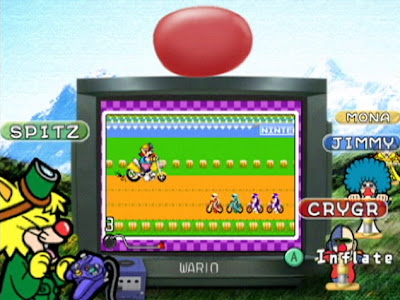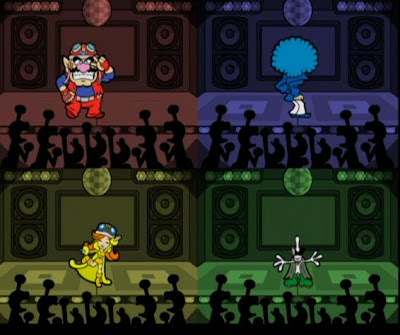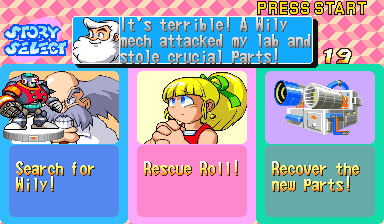The Short
Pros
- Very fun and furious co-op Zelda experience
- The inclusion of subtle competitive elements causes dissonance between teammembers, which is awesome
- Puzzles and dungeons are, for the most part, great fun with friends
- Controls are reasonable with regards to character management if you can't get the complete set of four buddies together
- Graphics look straight out of the SNES Link to the Past
- "Dark Link" verses mode is weirdly amazing, providing a four-player murder spree using 2D Zelda elements
- Seriously, it's a 2D Zelda game. We never get these anymore. I'm going to take what I can get here.
Cons
- Need at least two Game Boy Advances and the link to Gamecube cables to play co-op
- Playing single player is sort of a rotten experience
- Despite being mostly good, some puzzle elements are sloppily designed, especially for a Zelda game
- I praised the SNES style graphics, but they do look a bit...fuzzy in SD
- Music is all recycled from other Zelda games. As in, directly lifted. Well, there is one remix, I guess.
- Story is lame and forgettable; just a collect-a-thon quest
- Game puzzles get predictable at around the 7th or 8th world
- No real sense of exploration, a major staple of the Zelda franchise
 |
| The calm before the inevitable storm. |
The Long
When people say Nintendo has never mixed up the Zelda formula since Ocarina of Time, I sort of cringe a little. Yeah, the 3D Zelda games have sort of gotten stale (not "sort of;" they have gotten stale), but there's been a good batch of weird offshoot games since then. The DS Zelda games are a good example of Nintendo using a touch screen to change the Zelda experience, but what particularly stands out in my memory is Four Swords Adventures on the Gamecube.
Please allow me a little self indulgence here. My first experience with Four Swords Adventures was my freshman year in college. A friend had the game but no Game Boys, and I (for some reason) had two Game Boy Advance SPs. We borrowed three cords from a friend, and then hauled my other buddy's portable TV, Gamecube, and Game Boy Player (the attachment for the Gamecube that lets you play Game Boy Advance games on it) into our tiny dorm room. with two friends on Game Boys and one using their Gamecube as a Game Boy, we burned through about half of the game in a night. Let me tell you this: things got violent. Very violent. I believe we had to ban a certain player from ever using the Fire Rod ever again...and I think that player was me. Yeah, I'm kind of a pyromaniac...but hey, that field of bushes needed to be burned! It's not my fault all my teammates were in it when I torched it!
All that aside, I've recently picked up the game as well as a few cables to play with my wife in two-player to see if the experience is still the frantic, at-each-other's-throats co-op experience I remembered fondly in college. Was it? Well, read on and I'll tell ya.
 |
| Had this been with my friends, somebody was probably in that explosion. |
Zelda: Four Swords Adventures strips the Zelda formula down to it's absolute basic, and changes a good deal of things in order to make the co-op experience work. Gone is any sense of story (though, to be honest, Zelda games are hardly Shakespeare): six (or was it seven?) magic sage ladies have been stolen, as have four mystical gems for some knights or something. When Link yanks the fabled Four Sword (imaginative name, that) from the stone like King Arthur, he splits into four different colored versions of himself that love to fight, bicker, and throw each other off pits out of spite. It's also good that happens, because apparently the whole world was designed around four people navigating it, which seems really inconvenient if you start thinking about it too hard.
In stripping the formula down, you lose a lot of what makes Zelda, well, Zelda to people. There's no exploration here; the game is divided very evenly into nine worlds, each with three levels (hey, kind of like every Mario game ever). These worlds follow the usual themes (forest world, ice world, fire world, etc.), and there is no carry-over between levels. Items you find in each level such as boomerangs, bombs, and the dreaded fire rod, all stay in their worlds after you beat them. It's more "Zelda arcade" than anything.
 |
| Ooh...pretty. Now throw Purple over the ledge to get the force gems. |
While purists might take offense, I applaud Nintendo for doing this, because Four Swords Adventures, at its core, is not a traditional Zelda game. At it's very forefront it's a co-op puzzle slash action game, and one that Nintendo knew would be hard to get friends together for. Nobody wants to slog through seven hours of Link to the Past on four player co-op; people have lives. Shrinking it into stages that last around thirty minutes to an hour and a half makes it a great "pick up and play" game, which is what it needed. You still get the basic Zelda gist of tossing boomerangs and opening doors with keys, just in bite sized chunks.
And it's good that way, because the puzzle are, frankly, some of the worst in the franchise. Now, let me remind you that this is the Zelda franchise we are talking about here, so even at its worst the puzzle are decent at least. My main issue with Four Swords Adventures is the lack of conveyance. You play a whole temple learning that sinking-sand is bad, adapting tricks to get through it quickly so you don't sink to the bottom and die. Then you have a room where the only way out is to sink to the bottom, with no indication, prompts, or even hints that this is the correct way to go. And that's far from the worst example. Many puzzles involve using items in ways the game never taught you, and only using them that way once. Rooms have levers and stuff you can push/pull that only works sometimes. And don't get me started on the bracelet that "lets you lift anything!" which actually translates into "some trees, sometimes, and only if you come at them from the right angle." But hey, at least you can toss the trees at your buddies.
And there we have the saving grace for this game: the fantastic competitive co-op.
 |
| Game Boy Advance: Now a bomb shelter. |
If you have the resources (meaning at least two GBAs, link cables, and a willing friend), Four Swords is an absolute riot multiplayer. First off, the game is designed exceptionally well when it comes to co-op required puzzles. Enemies, including bosses, often are "color coded," meaning only a certain color Link can damage them. This requires your team to be fast on the draw, as this color can often shift after being hit, and gives each person a time to shine. Puzzles also do this, with certain blocks only able to be pushed by certain colors, and the limited number of sub-items causing each Link to be specialized for a specific thing. You have your guy who has the dash boots and can run across pits, but can't use the fire rod to melt the ice on the other size. You have to work together as a team to pull through most of the game.
But where the game is really fun is the parts where you don't work as a team and instead try to hack each others' faces off. Let me tell you about Force Gems for a second.
 |
| Force Gems: Making your friends hate you since 2004 |
Force Gems are the Rupee replacement in this game. Essentially, they drop all the time (mostly when solving puzzles or killing enemies), and when your team collectively gets 2,000 on tap you unlock a more powerful spin attack. However, where this matters is at the end of each stage you and your friends are ranked. You're given bonus points for killing the most enemies, having the most health at the end, and penalized for dying. And then they add your total Force Gems to the mix, and whomever is #1 gets to be awesome while the rest bow their heads in shame.
Add the mechanic that burning your friends with the fire rod causes them to drop Force Gems, and things get fiesty.
There's a certain incentive to keep your gems so that you'll reach maximum power (and if someone drops 100 or more at once, Tingle will come from off screen and steal it away, so everybody loses), but depending on your friends the real goal is to beat the stuffing out of whomever has the most. This includes but it not limited to:
- Picking them up and throwing them off a cliff
- Baiting enemies to them so they get hit
- Burning them with the fire rod (my personal favorite)
- Luring them out into a field then burning the field with the fire rod
- Tossing them out of their GBA screen just when an insta-kill bomb goes off
- Grabbing them with a boomerang to pull them off cliffs or into enemies
- Throwing trees at them
- Generally being a butt to your "buddies"
This "co-op but competitive" vibe is what makes the game awesome. And you know Nintendo knew it, because they plan just enough dead time between puzzles that you'll get antsy and start being jerks. Not only that, usually when someone solves a puzzle they are rewarded with a hefty amount of Force Gems, incentivizing people to race to the solution (or just let your friends do it and steal the reward, HAHAHAHA!).
Or you can all just fight. For like twenty minutes. On the same screen. That happens a lot, too.
 |
| I hate all my friends now. Thanks, Four Swords! |
So as a Zelda game, Four Swords is just passable. But as a co-op (and, dare I say, "party") game, Four Swords is incredible. The Zelda elements are just icing on the cake, with the somewhat easy puzzles really being there to incite more and more vicious competition amongst friends. It's pretty brilliant, in a way.
All this is completely removed if you play single player, which is absolutely awful. While it's true you don't need a GBA to play Four Swords by yourself (a standard Gamecube controller will suffice), the rest of the Links trail behind you like obedient puppies, and the competitive nature (aka the best part of the game) is lost. Playing this like a normal single player Zelda is, frankly, super lame. And considering it isn't a great Zelda game under there, you'll probably either get bored or frustrated very quickly.
Which brings me to another point: the GBA usage. It's primarily used in two situations: going indoors (caves, houses, etc.) or when you are in the Dark World. And while I admit the game does one or two clever thing with it (you can pick up "light world" buddies while in "dark world," making for a few interesting puzzles), I hardly found it necessary. Splitting the screen might have been cumbersome, but the game probably could have been designed around four-player co-op on just one screen. Having to find four freaking GBAs (or somebody with an extra TV, Gamecube, and Game Boy Player) as well as cords was hard enough back when this game was new, and now it's just as big a pain. While I will say it's worth it if you already have the GBAs (link cords are on eBay for like $5, and the game is only around $20), I think the forced GBA linkage sort of killed this offshoot.
 |
| That looks totally safe. |
Graphically, I have mixed feelings. While I like the very obvious Link to the Past throwback, it doesn't look like they did any real graphical improvements except for fire effects. As in, this seriously looks exactly like Link to the Past. You know, the game that came out on a system two generations before the Gamecube. The obvious dissonance between the bits they wholesale ripped and the few new things they added makes it extra weird, and with modern games these days adapting a "retro" look much better, Four Swords feels a bit like a cash-in on the graphics department.
Same goes for the music, which again...mostly straight up ripped from Link to the Past or Ocarina of Time. There's maybe two or three remixes of themes (I like the snow mountain's song, which is Death Mountain with like a flutey, softer feel to it), but stuff like the castle and cave songs are the exact same song, in the exact same midi chipset from the SNES. Dudes, you had a disc. Reorchestrate them or something, seriously.
 |
| Four Links enter, one Link leaves. |
I'll give a passing comment on two other minor features: Tingle's Tower and Shadow Link Battle. Tingle's Tower is a minigame collection that pops up after you beat the second level in each world. It's cute, but frankly crappy. Ignore it.
Shadow Link Battle is actually kind of cool. Basically it tosses the four of you in a small stage, then randomly spawns powerups, bombs, etc. You can even grab a chicken and toss it at enemies to steal life, which is downright awesome. While it's hardly Halo or anything, it's a laugh riot with friends, and helps you blow off steam if your friend was a particular Force Gem robbing jerk in the main game.
All in all, Four Swords Adventures is a pretty dang great multiplayer experience, with its only real issues being the mediocre Zelda elements and the high bar for entry. All that aside, don't let my negativity bring you down: if you have a Gamecube (or a backwards compatible Wii) and a few GBAs lying around, pick up some cables, Four Swords, and some buddies and have a great time. I should also mention quickly: the game works great with just two players as well. While you have to micromanage Blue and Purple, it still is a lot of fun (if a bit less competitive, at least when playing with your significant other). Just...don't play it by yourself. Really.
Four (swords) out of Five. And hey, Nintendo? This game would work great online, you hear? And since the WiiU doesn't suck online (and also has a big fat screen in the controller), maybe it's time for a reboot that doesn't require four handhelds to play?













































